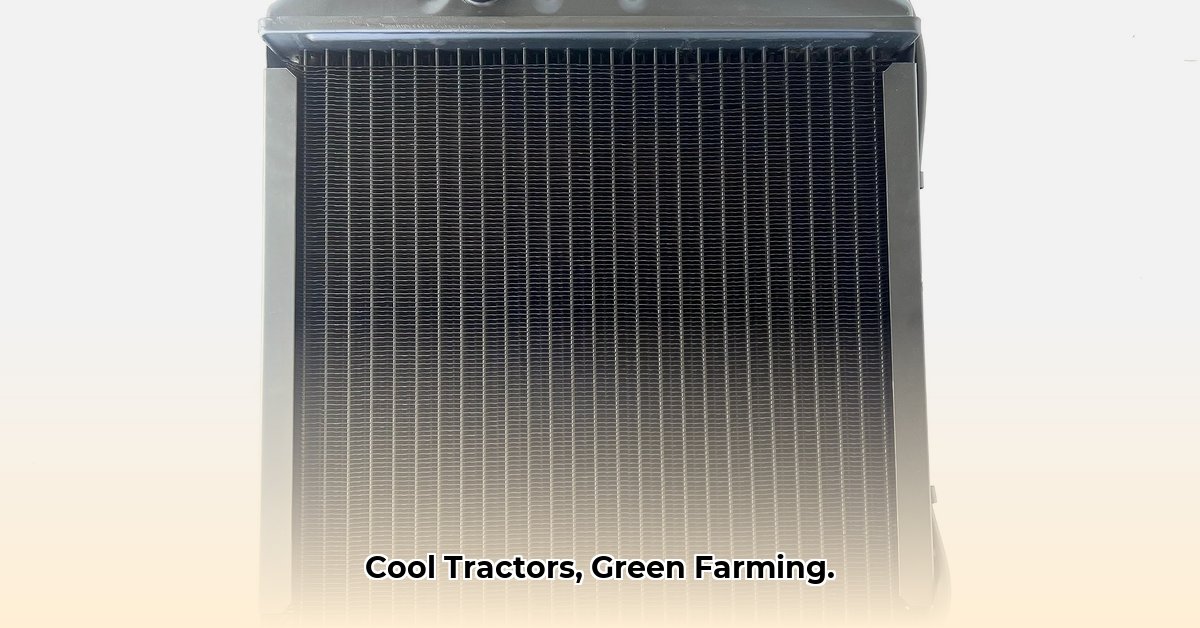
Understanding Tractor Radiator Function and Efficiency
A tractor's radiator is crucial for preventing engine overheating, ensuring optimal performance, and extending engine lifespan. Its efficiency directly impacts fuel consumption and overall operational costs. Several key factors influence radiator efficiency:
- Material: Aluminum radiators are often preferred for their lighter weight and generally lower manufacturing carbon footprint compared to copper. However, copper may offer superior performance in extreme operating conditions. Research into advanced materials, such as composites, continues to explore improved heat dissipation and sustainability.
- Design: The radiator's design—fin density, airflow pathways, core thickness—significantly affects heat transfer efficiency. Optimized designs maximize heat dissipation, minimizing the risk of overheating and improving fuel economy. Innovations in fin geometry and core construction are constantly improving performance.
- Maintenance: Regular cleaning and coolant flushes are essential for maintaining peak radiator performance. Accumulated debris restricts airflow, reducing efficiency and potentially leading to engine damage. Prompt attention to leaks and corrosion is crucial for longevity. A neglected radiator can drastically reduce efficiency and increase fuel consumption.
For more on engine fluids, see Rotella information.
The Environmental Impact: From Material Extraction to Disposal
The environmental impact of agricultural radiators extends beyond their operational phase. Consider the entire lifecycle:
- Material Extraction and Manufacturing: The mining and processing of raw materials (aluminum, copper, plastics) consume significant energy and generate greenhouse gas emissions. Manufacturing processes are energy-intensive, contributing to the radiator's overall carbon footprint. Transportation of materials and finished products adds further environmental burden.
- Operational Phase: Radiator inefficiency directly impacts fuel consumption. A poorly functioning radiator forces the engine to work harder, leading to increased fuel use and higher emissions.
- Disposal: Improper disposal of spent radiators poses a serious environmental risk. Coolant leaks contaminate soil and water, while improper disposal of materials contributes to landfill waste. Responsible recycling is essential to minimize the environmental impact. Recycling rates are currently below what is ideally needed for achieving environmental sustainability and circular economy objectives.
Practical Steps for Improvement: Actionable Intelligence
Optimizing radiator sustainability requires collaborative efforts from all stakeholders:
1. Original Equipment Manufacturers (OEMs):
- Invest in R&D: Develop radiators using sustainable materials (e.g., recycled aluminum, advanced composites) and efficient manufacturing processes (e.g., reduced energy consumption, lean manufacturing). Target a 15% reduction in manufacturing carbon footprint within five years.
- Design for Durability and Recyclability: Engineer radiators for extended lifespan and ease of disassembly for efficient material recovery. Implement Design for Disassembly (DfD) principles to facilitate material separation during recycling.
- Promote Recycling Programs: Establish robust take-back programs and partnerships with recyclers to ensure responsible end-of-life management. Aim for a 90% recycling rate for all end-of-life radiators within a decade.
2. Parts Suppliers:
- Source Sustainable Materials: Prioritize suppliers committed to sustainable practices and responsible sourcing of raw materials.
- Offer Extended Warranties: Incentivize the purchase of high-quality, durable radiators, reducing replacement frequency.
- Collaborate on Lifecycle Assessment: Work with OEMs to conduct comprehensive lifecycle assessments of radiator materials and designs.
3. Farmers and Agricultural Businesses:
- Implement Preventative Maintenance: Regularly inspect, clean, and maintain radiators to extend their lifespan. Aim for at least an annual inspection and cleaning.
- Prioritize Efficient Radiators: When replacing radiators, consider efficiency and environmental impact as key decision factors. Consult with agricultural engineering experts on equipment selection.
- Proper Disposal: Utilize designated recycling programs for used radiators. Avoid improper disposal, which can lead to significant environmental damage.
4. Governments and Regulatory Agencies:
- Incentivize Sustainable Practices: Implement policies such as tax credits or subsidies to encourage the adoption of eco-friendly radiator designs and manufacturing processes.
- Establish Environmental Standards: Develop and enforce strict regulations for the manufacturing, use, and disposal of agricultural radiators.
- Fund Research and Development: Invest in research to develop and implement new, environmentally sustainable technologies related to agricultural machinery cooling systems.
5. Recyclers and Waste Management Companies:
- Improve Recycling Infrastructure: Invest in advanced processing technologies to efficiently separate and recover valuable materials from spent radiators.
- Develop Closed-Loop Systems: Collaborate with OEMs and suppliers to establish closed-loop recycling systems, maximizing material reuse.
- Enhance Material Recovery: Develop innovative methods to recover and reuse materials from all components of the radiator, including plastics and metals.
Material Comparison: Aluminum vs. Copper
| Material | Advantages | Disadvantages | Sustainability Considerations |
|---|---|---|---|
| Aluminum | Lower manufacturing carbon footprint (generally); Lightweight; Recyclable | Lower durability in extreme conditions (potentially); Corrosion risk | High recyclability is crucial; focus on closed-loop systems and responsible sourcing. |
| Copper | Excellent heat conductivity; High durability | Higher manufacturing carbon footprint; Lower recyclability (compared to Al) | Recycling is critical to mitigate environmental impact; explore improved recycling methods. |
Case Studies (Future Research)
Further research will include case studies demonstrating the effectiveness of the recommended strategies. These studies will highlight successful implementations of sustainable radiator practices across various agricultural settings.
Conclusion
Improving the sustainability of agricultural radiators necessitates a collaborative, multi-stakeholder approach. By implementing the strategies outlined above, we can significantly reduce the environmental footprint of agricultural machinery, fostering a more sustainable future for agriculture. The economic benefits associated with increased efficiency and reduced waste will further incentivize the adoption of these crucial practices.